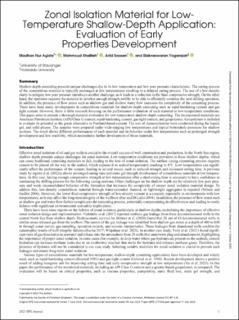| dc.contributor.author | Agista, Madhan Nur | |
| dc.contributor.author | Khalifeh, Mahmoud | |
| dc.contributor.author | Saasen, Arild | |
| dc.contributor.author | Yogarajah, Elakneswaran | |
| dc.date.accessioned | 2023-10-12T11:56:29Z | |
| dc.date.available | 2023-10-12T11:56:29Z | |
| dc.date.created | 2023-09-28T10:24:22Z | |
| dc.date.issued | 2023 | |
| dc.identifier.citation | Agista, M.N., Khalifeh, M., Saasen, A. & Yogarajah, E. (2023) Zonal Isolation Material for Low-Temperature Shallow-Depth Application: Evaluation of Early Properties Development, SPE Journal, SPE-217434-PA | en_US |
| dc.identifier.issn | 1086-055X | |
| dc.identifier.uri | https://hdl.handle.net/11250/3096096 | |
| dc.description.abstract | Shallow-depth cementing presents unique challenges due to its low temperature and low pore pressure characteristic. The curing process of the cementitious material is typically prolonged at low temperatures resulting in a delayed curing process. The use of a low-density slurry to mitigate low pore pressure introduces another challenge, as it leads to a reduction in the final compressive strength. On the other hand, the operation requires the material to develop enough strength swiftly to be able to efficiently continue the next drilling operation. In addition, the presence of flow zones such as shallow gas and shallow water flow increases the complexity of the cementing process. There have been many developments in cementitious materials for shallow-depth cementing such as rapid-hardening cement and gas tight cement. However, there is little research focusing on the performance evaluation of each material at low-temperature conditions. This paper aims to present a thorough material evaluation for low-temperature shallow-depth cementing. The incorporated materials are American Petroleum Institute (API) Class G cement, rapid-hardening cement, gas tight cement, and geopolymer. Geopolymer is included to evaluate its potential as the green alternative to Portland-based cement. The sets of characterization were conducted during the liquid, gel, and solid phases. The samples were prepared under wide-ranging low temperatures and typical bottomhole pressures for shallow sections. The result shows different performances of each material and its behavior under low temperatures such as prolonged strength development and low reactivity, which necessitates further development of these materials. | en_US |
| dc.language.iso | eng | en_US |
| dc.publisher | Society of Petroleum Engineers | en_US |
| dc.rights | Navngivelse 4.0 Internasjonal | * |
| dc.rights.uri | http://creativecommons.org/licenses/by/4.0/deed.no | * |
| dc.subject | geologi | en_US |
| dc.subject | olje og gass | en_US |
| dc.subject | borevæske | en_US |
| dc.title | Zonal Isolation Material for Low-Temperature Shallow-Depth Application: Evaluation of Early Properties Development | en_US |
| dc.type | Peer reviewed | en_US |
| dc.type | Journal article | en_US |
| dc.description.version | publishedVersion | en_US |
| dc.rights.holder | © 2023 The Authors | en_US |
| dc.subject.nsi | VDP::Teknologi: 500::Berg‑ og petroleumsfag: 510::Petroleumsteknologi: 512 | en_US |
| dc.subject.nsi | VDP::Matematikk og Naturvitenskap: 400::Geofag: 450::Petroleumsgeologi og -geofysikk: 464 | en_US |
| dc.source.journal | SPE Journal | en_US |
| dc.identifier.doi | 10.2118/217434-PA | |
| dc.identifier.cristin | 2179743 | |
| dc.relation.project | Norges forskningsråd: 309646 | en_US |
| dc.source.articlenumber | SPE-217434-PA | en_US |
| cristin.ispublished | true | |
| cristin.fulltext | original | |
| cristin.qualitycode | 2 | |

